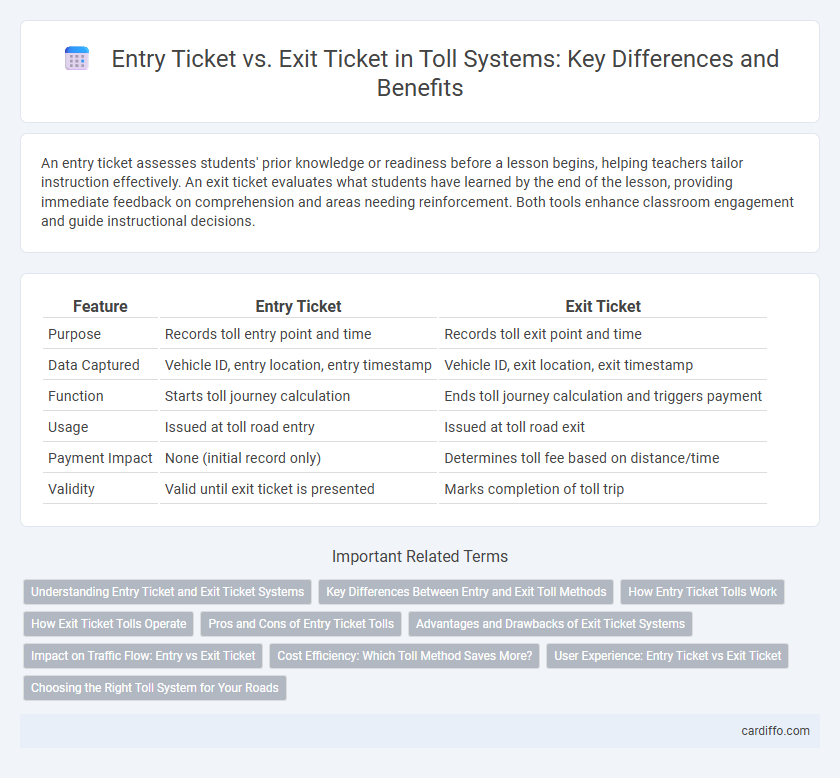An entry ticket assesses students' prior knowledge or readiness before a lesson begins, helping teachers tailor instruction effectively. An exit ticket evaluates what students have learned by the end of the lesson, providing immediate feedback on comprehension and areas needing reinforcement. Both tools enhance classroom engagement and guide instructional decisions.
Table of Comparison
| Feature | Entry Ticket | Exit Ticket |
|---|---|---|
| Purpose | Records toll entry point and time | Records toll exit point and time |
| Data Captured | Vehicle ID, entry location, entry timestamp | Vehicle ID, exit location, exit timestamp |
| Function | Starts toll journey calculation | Ends toll journey calculation and triggers payment |
| Usage | Issued at toll road entry | Issued at toll road exit |
| Payment Impact | None (initial record only) | Determines toll fee based on distance/time |
| Validity | Valid until exit ticket is presented | Marks completion of toll trip |
Understanding Entry Ticket and Exit Ticket Systems
Entry ticket systems require drivers to collect a ticket upon entering a toll road, which is then used to calculate toll fees based on the exit point. Exit ticket systems involve paying the toll fee directly at the exit, often determined by distance traveled or predetermined zones. Understanding these systems ensures efficient toll collection and accurate fee assessment, reducing congestion and enhancing traffic management.
Key Differences Between Entry and Exit Toll Methods
Entry toll methods charge vehicles upon entering a toll road, using mechanisms like toll booths or electronic sensors to record vehicle entry data. Exit toll methods calculate charges based on the distance traveled by recording both entry and exit points, ensuring fees are proportional to road usage. Key differences include timing of payment and fee calculation, with entry tolls applying flat rates upfront and exit tolls offering variable pricing contingent on trip length.
How Entry Ticket Tolls Work
Entry ticket tolls operate by issuing a ticket when vehicles enter the toll road, recording the entry point and time. Upon exit, drivers present the ticket to calculate the toll fee based on the distance traveled or time spent on the toll facility. This system ensures accurate charging, optimizing traffic flow and revenue collection on highways and tunnels.
How Exit Ticket Tolls Operate
Exit ticket tolls operate by collecting fees from drivers as they leave a toll road or highway, often using electronic toll collection systems like RFID transponders or automatic license plate recognition cameras. This method allows toll operators to charge based on the actual distance traveled within the toll zone, enhancing fairness and reducing congestion at entry points. Exit ticket systems improve traffic flow efficiency by eliminating the need for upfront payment, enabling seamless vehicle movement until the toll is calculated upon exit.
Pros and Cons of Entry Ticket Tolls
Entry ticket tolls require drivers to obtain a ticket upon entry and pay based on the distance traveled, ensuring a fair pricing model that correlates with road usage. This system reduces congestion at exits but can cause delays at entry points and requires infrastructure for ticket distribution and tracking. However, it promotes equitable toll collection by charging users proportionally to their travel, benefiting long-distance commuters while potentially inconveniencing short-distance drivers.
Advantages and Drawbacks of Exit Ticket Systems
Exit ticket systems offer real-time data collection on driver behavior and traffic flow, enabling efficient toll revenue management and congestion reduction. Their reliance on accurate license plate recognition or account linking may raise privacy concerns and require advanced technology investments. While exit tickets promote fairness by charging based on distance traveled, potential system errors can lead to billing disputes.
Impact on Traffic Flow: Entry vs Exit Ticket
Entry tickets at toll plazas manage incoming vehicle flow by controlling access, which helps prevent congestion before vehicles merge onto highways. Exit tickets, on the other hand, regulate traffic leaving the toll roads, ensuring a smoother and more predictable dispersal of vehicles onto local roads. Proper coordination between entry and exit ticket systems minimizes bottlenecks, optimizing overall traffic flow and reducing delays.
Cost Efficiency: Which Toll Method Saves More?
Entry tickets generally offer better cost efficiency for toll road users by providing a fixed rate based on travel distance, reducing the risk of overpayment due to unexpected detours or delays. Exit tickets rely on variable pricing that accumulates according to actual usage, potentially increasing costs during high congestion or extended travel times. Choosing entry tickets optimizes budgeting and ensures predictable toll expenses, making them a more economical option for regular commuters.
User Experience: Entry Ticket vs Exit Ticket
Entry tickets streamline user experience by allowing travelers to pay tolls upon entering a toll road, reducing delays at the exit ramp. Exit tickets improve accuracy in toll charges by calculating fees based on the exact distance traveled, enhancing fairness for users. Both systems impact traffic flow and convenience, with entry tickets favoring quicker entry and exit tickets providing precise billing.
Choosing the Right Toll System for Your Roads
Choosing the right toll system for your roads involves evaluating entry ticket and exit ticket models based on traffic patterns and revenue goals. Entry ticket systems charge drivers at the start of their journey within a toll zone, ideal for predictable routes and simpler administration. Exit ticket systems calculate tolls based on distance traveled, offering precise revenue collection for varied trip lengths and extensive networks.
Entry Ticket vs Exit Ticket Infographic

 cardiffo.com
cardiffo.com